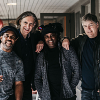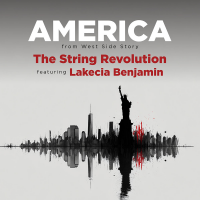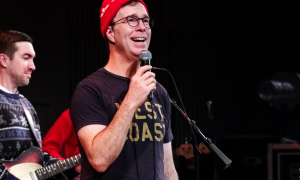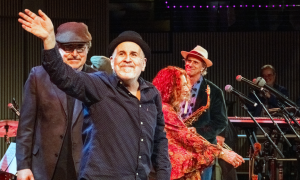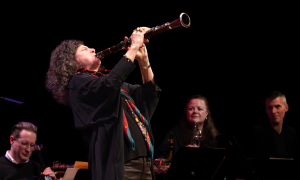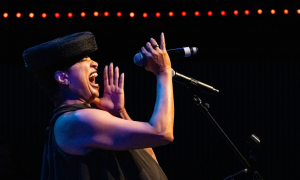Home » Jazz Articles » Live Review » Festival International de Jazz de Montréal 2018: Part 1
Festival International de Jazz de Montréal 2018: Part 1
As good as the Coffin-era Flecktones was, it just never seemed to possess the magic of the original lineup, and so it was huge news when it was announced that the original Béla Fleck & The Flecktones lineup was not just reuniting for an album, Rocket Science (E One, 2011), but that they'd be hitting the road again, including a performance at the 2012 Festival International de Jazz that made clear how, when you have the chemistry and sense of family that the original lineup possessed, you never lose the magic.
And so, Béla Fleck & The Flecktones being the first group to win FIJM's Miles Davis Award was entirely appropriate; few bands today could meet the festival's criterion of "honour[ing] a great international jazz musician for the entire body of his or her work and influence in regenerating the jazz idiom." Of Fleck & The Flecktones, the festival has written: "Renowned for their bottomless creativity, fiery concerts and a unique style steeped in jazz, classical music, bluegrass, African music, electric blues and even East European folk, Béla Fleck and the Flecktones rank as one of the most innovative groups on the global music scene, challenging the limits of jazz and driving the music off the beaten track."
But after being given the award at the start of their 2018 FIJM appearance at Place des Arts' Théâtre Maisonneuve (coincidentally, a much better sounding room for a group like this than PdA's large Salle Wilfred-Pelletier), the capacity crowd had to wait, as opening act, Delvon Lamarr Organ Trio, delivered a short but extremely well-received set that most certainly made some new fans out of a crowd largely unfamiliar with this Seattle-based, soul/jazz-infused organ/guitar/drums trio.
Performing music largely from its studio debut, Close But No Cigar (Colemine, 2018), but also drawing upon its early Live at KEXP! (Colemine, 2018) and the just-recorded but due out in 2019 second studio release, Lamarr was definitely a member of the church of the Hammond B3 organ. Supported not being precisely the appropriate term but, instead, collaborating with guitarist Jimmy James and drummer David McGraw, Lamarr's set was high on energy, church infused spirituality and flat-out soul. The best comparison would be Booker T & the MG's, but on steroids, as the trio worked its way through covers of Curtis Mayfield and Big Big John Patton to reworks of a tune with which Lamarr group up in church, and a handful of similarly booty-shaking originals.
James combined Steve Cropper's bright rhythmic sense with B.B. King's blues-fueled bends, meshing perfectly with Lamarr's mesh of everyone from Patton and Booker T. Jones to Jack McDuff, Johnny "Hammond" Smith and even hints of Shirley Scott, though his language was less overt jazz and, like James, leaned more towards blues as soul. Being the only white man in the band, Lamarr introduced McGraw as "the piece that holds the band together...kinda like the creamy centre of an Oreo cookie," which got both huge laughter and applause from the appreciative audience, giving the group a well-deserved standing ovation at the end of its short, roughly 30-40 minute set. And, true enough, McGraw may have used a small kit—snare, bass drum, one rack tom and one floor tom, along with hi-hat and two cymbals that sounded especially sweet, especially during his brief solo on the short piece that closed out the set—but he kept the engine running all the way through the set.
As with Mike Stern the night before, booking an opening artist before the main event can be a dicey proposition, but in both cases the FIJM programming team not only made perfect choices, but significantly different ones that eliminated any possibility of comparison to the headliners.
It's been six years since the original Béla Fleck & The Flecktones played together, but from the moment Levy began on Jew's harp for an exhilarating opener, "Frontiers," from the group's 1990 debut, it was clear, once again, that time simply doesn't destroy the kind of magic these four virtuosic musicians share. "You're my brothers," Fleck said when he spoke to the audience after a four-song opening that also included Flight of the Cosmic Hippo's funkier "Flying Saucer Dudes," an even deeper-grooved "Magic Fingers" from UFO Tofu and, from Fleck's '95 Grammy-nominated solo album, Tales From the Acoustic Planet (Warner Bros.), a more electrified (and electrifying) "Up and Running."
Not unlike just about every American act that plays in Canada these days (Ry Cooder, as well, but in a different way), Fleck began his introduction by saying "We'd kinda like to stay here if that's OK."
He also marveled that, after a previous six shows in six nights, the magic was clearly back. And it was. The set included deep cuts like Béla Fleck and The Flecktones' two-part "Mars Needs Women," with its balladic "Space is a Lonely Place" and knottier, more up-tempo "They're Here," along with Rocket Science's mind-boggling exploration of all things eleven, "Life in Eleven" and a brightly swinging "Hurricane Camille," from the group's debut. Throughout, Fleck, Levy, Wooten and Future Man demonstrated that nothing is set in concrete as they stretched some of the material out, playing liberally with tempo and, with each and every one of them having grown significantly in the intervening years, approaching the material with fresh ears and fresh insights.
Barring those first four tunes, the set was democratically chosen on the fly, as Fleck passed the microphone around and asked each of his brothers what song on their very long set list they'd like to play. Beyond those deep cuts, they made sure to include songs that Fleck fans have come to expect: Wooten's funkified "Sex in a Pan," from UFO Tofu, along with Fleck's ambling "Sunset Road" and typical usual set-closer, "The Sinister Minister" (both from Béla Fleck and The Flecktones), the latter which included Victor Wooten's usual incomparable bass solo, though he only flipped his bass around his band and back to front again once, rather than the many times he used to. But once was enough for the similar crowd to go wild.
The set also included some new material. Following a first encore (after the third standing ovation of the night) of the audience participation title track from Flight of the Cosmic Hippo (fingers snapping, men going "oooh," women following with "aaah"), Fleck asked if the audience wanted one more (they did), and closed the evening with a new short but truly death-defying piece of musical acrobatics, the aptly titled "Vertigo." He described it as "a new tune, complicated, we just learned it," and then, after his band mates agreed to his question as to whether or not they needed a quick run-down, were subjected, along with the crowd, to Fleck's rapid-fire description that began with "two quick bars of five, then one of six, another two of five, one of six..." and became only knottier and more complicated from there. It was a short piece, maybe four minutes long, but probably long enough, though Fleck, Levy, Wooten and Future Man all pulled it off with effortless confidence.
There was another relatively new tune, "Juno," written five year's ago for Fleck's then-newborn son, its genesis described by the banjoist. "He arrived three weeks early, and I couldn't find a flight that would get me there in time. So I had to play a show and missed his birth. I live in Nashville," he continued, dryly adding that he "caught a 4am red eye and found myself in the purgatory known as the Dallas/Fort Worth airport." The simpler, more lyrical "Juno" (which may come from his 2017 collaboration with the Colorado symphony, Juno Concerto, was evidence of Fleck's capacity for lyrical beauty, even if he is, perhaps, better known for compositions so metrically challenging that few but these four players could actually pull them off.
In a group this talented, nobody outshined anyone else. Instead—and a very different experience to the Coffin/Flecktones lineup, which seemed more about the virtuosity and less about the music—each and every member of the Flecktones have proven themselves both extraordinarily talented and unmistakable innovators on their respective instrument(s). Fleck's technique has only grown deeper with time, as he built motif-driven improvised passages that were completely about respecting the music, even as he demonstrated an almost unbelievable facility at threading melodic needles through the tight pin holes of his and his band mates' writing.
Wooten's effortless mastery on electric bass (largely fretted this evening, though he did pull out a fretless for the glissando-driven "Flight of the Cosmic Hippo) has only become more natural, more organic, whether he was slapping, thumb-popping, tapping, contributing light-speed phrases or all the other mind-bending things he does on an instrument that truly feels like an extension of his body, mind and soul.
Future Man's Drumitar (a new version first seen at the 2012 FIJM show, that is much smaller than the modified SynthAxe he originally used) was as impressive as ever, but even more so when he sat behind his modified drum kit and began playing the acoustic set with his right hand and his Drumitar with his left. From close seats, it was actually possible to see a small laptop amongst his onstage gear, where his Drumitar work was actually visually translated to the virtual kit he was effectively playing.
It's a long way from the Flecktones' early days, and Levy touring with an electronic keyboard utilizing, amongst other things, sampled piano. Now, he's able to ask for (and get) a Steinway grand piano, and he spent the evening moving back and forth from his piano stool, where he played piano and, oftentimes, harmonica simultaneously, to front of stage stage, where he sometimes played through a microphone on a stand, but other times grabbed the mike so he could move around more freely. As strong a pianist as he absolutely was, however, it was his harmonica work that was most impressive, especially during his a cappella solo introduction to "Life in Eleven," where he actually alternated so rapidly between consonant tritone chords (and on a diatonic harmonica, to boot) and rapid-fire single-note lines—bent, twisted and turned on their side—that it felt like there were two players onstage rather than just one. He used to be introduced as the "man with two brains" by Fleck, for his ability to simultaneously play keyboards and harmonica, but after witnessing this solo, it made perfect sense when Fleck added "the man with two tongues" to his intro.
With Montréal the seventh show of an originally planned short tour of just eight performances, the group has already added five more dates. Whether or not it continues to expand into a larger tour, and whether or not the group ever returns to the studio (though their FIJM show was recorded for international television broadcast, so hope springs that they might release a live album or, with this multi-camera shoot, a live DVD/Blu Ray), Béla Fleck & The Flecktones' FIJM performance and winning of the Miles David Award made the group's return to Montréal a most welcome event that will surely go down as one of the best performances of the 39th edition...and, even, the festival's nearly 40-year history.
July 2: Hommage à Carla Bley, Monument National
When Carla Bley was forced, at the eleventh hour, to withdraw from her planned FIJM performance with life partner and equally acclaimed electric bassist Steve Swallow in collaboration with Montréal's Orchestre National de Jazz, beyond concerns for the renowned pianist and composer's health, the question arose: what to do?Well, fortunately the ONdJ, formed in 2012 of some of the absolutely best musicians from the Montréal area and giving its first performance the following year, had been collaborating with Canada's crown jewel of jazz composers and arrangers, Christine Jensen. And so, following the old adage of "when life gives you a lemon, make lemonade" (though neither Jensen nor the ONdJ could hardly be called "lemons"), Jensen was recruited to turn Bley and Swallow's visit to FIJM into Hommage à Carla Bley, featuring seven guest performers, women all (with one exception), in these times of increase awareness for women's rights, and recognition that Bley was truly a trailblazer—a groundbreaking artist for women in jazz, emerging at a time when few women could be found beyond singers and the occasional pianist.
It's hard to know Bley's feelings on the subject, beyond her simply doing what she did so well from the very start, and transcending the "boy's club" that defined too much of the jazz scene in the mid-to-late '50s, when she first emerged as a pianist but, soon after, as a composer and bandleader who, beyond her sizeable discography, has paved the way for women like Jensen, Myriam Alter and Maria Schneider, amongst many others.
And so, as everyone hopes for Bley's recovery (she may be 82, but the world is simply not ready for her to be gone), Jensen led the Orchestre National de Jazz Montréal in a program that drew upon three of Bley's large ensemble recordings on her own WATT imprint: 1991's The Very Big Carla Bley Band; 1993's Big Band Theory; and 2008's Appearing Nightly.
With six different pianists including, alongside local stars Gentiane MG, Marie-Fatima Rudolf, Marianne Trudel, Francois Bourassa (the sole male guest) and Lorraine Desmarais, two New York-based musicians also made the long drive to Montréal: Jensen's increasingly—and appropriately—critically/popularly recognized sister, trumpeter Ingrid Jensen; and Texas-born pianist Helen Sung. With the exception of Rudolf and Ingrid Jensen, the rest of the guests contributed to one piece each, though given the length of Christine Jensen's choice for a set-opener, Appearing Nightly's nearly 30-minute, multi-movement suite, "Appearing Nightly at the Black Orchid," with its liberal quotes from standards including "My Foolish Heart" and "As Time Goes By," it could easily be suggested that Gentiane MG also contributed to more than just one piece.
Bley's writing is filled with a broad range of emotion, ranging from darker-hued lyricism and bright, joyous optimism to wry wit. All that and more was encapsulated in the show's opening piece that, in addition to providing specific solo spots for tenor saxophonist David Bellemare, trombonist Jean-Nicolas Trottier, soprano saxophonist (tripling on alto and flute) Jean-Pierre Zanella and trumpeter Aron Doyle, also went, round robin style, around the entire Orchestre at one point, providing everyone in the 17-piece ensemble a moment in the spotlight, an approach that was repeated again, later in the set. MG's approach to piano was not unlike Bley's: spare, with as much space as there were notes played, and a considered approach to voicings that applied, for that matter, to her playing throughout the piece.
Jensen's conducting, seen, of course, from behind, was firm yet relaxed, as she brought the Orchestre from moments as close to a whisper as a group this large and horn-infused can be, to more dynamic passages filled with burnished (sometimes brash) brass and a potent rhythm section, feat tie game double bassist Rémi-Jean LeBlanc and drummer Kevin Warren. If there was any issue with the performance, it was in the mix coming out into the house. Some soloists stood, others did not; some had clip-on microphones on their horns, others did not. And while the mix was largely fine during much of the set, from a relatively central position in the hall, when things kicked into high gear the drums often tended to overshadow everything else (despite Warren being clearly a superb drummer), as did passages where a soloist was being supported by the full band, with five saxophonists/flautists, four trombonists and four trumpeters. That organist Daniel Thouin, who had the capacity for being loud and overbearing was the precise opposite spoke to his ensemble-oriented approach.
Thouin rarely soloed, in fact, though his contributions to the Orchestre's overall complexion was not to be underestimated. And when he finally did get to solo, on the wonderfully balladic, set-closing "Lawns" (the only non-Bley composition of the set, written by Christine Jensen as a tribute to the pianist/composer), his considered approach to soloing with clear compositional focus was well worth the wait.
Ingrid Jensen also performed on "Lawns," as well as two Bley pieces: Appearing Nightly's buoyantly swinging "Awful Coffee," next to Sung, and Big Band Theory's more relaxed and, at times' atmospheric "Fresh Impression," with Lorraine Desmarais on piano. As always, Jensen's tone was a thing of beauty, with a particular strength in the instrument's lower register that few explore, in addition to being able to hit, Kenny Wheeler-like, some truly stratospheric high notes. Any performance with Ingrid Jensen in it (and sister Christine, too) is bound to be worth seeing, and this was no exception.
Both "Awful Coffee" and, from the same album, the appropriately titled "Greasy Gravy" (featuring Marianne Trudel), with its slow and, yes, greasy groove, made references to other songs dealing with food, including Herbie Hancock's "Watermelon Man," Dizzy Gillespie's evergreen, "Salt Peanuts" and Ray Henderson's "You're the Cream in My Coffee." The Orchestre even shouted out another Gillespie reference in the midst of Jensen's solo during "Awful Coffee": "Hey Pete, Let's Eat Mo' Meat." Suffice to say that, while these are all part of the script' the Orchestre nevertheless imbued them with the appropriate dry, understated sense of humor so endemic to Bley's writing.
Every pianist invited to perform was suitably impressive. Bourassa, whose solo piece, "Pièce solo dédiée a Carla Bley" was a relentless stream of invention and virtuosity, was particularly notable, as was the especially intense Sung and equally masterful Desmarais. But as undeniably masterful as every invited pianist was, only a couple, specifically Gentiane MG and Marie-Fatima Rudolf, captured the spare, restrained and considered essence of Bley the pianist, whose playing, in particular on her two recent ECM trio releases with Swallow and saxophonist Andy Sheppard (2013's Trios and 2016's Andando el Tiempo), is especially revelatory.
Instead, Trudel, Sung, Bourassa and Desmarais delivered extraordinary performances, to be sure; but beyond Bourassa's self-penned solo tribute, it's hard to say if the others did the music full justice. Of course, a tribute need not be one that specifically references its subject, and there's little doubt that the restrained yet nevertheless freewheeling Bley would (as did Christine Jensen) encourage anyone and everyone performing her music to be exactly who they are.
And that dictum was, most definitely, the modus operandi for Christine Jensen and Orchestre National de Jazz Montréal's Hommage à Carla Bley. As frantic as it must have been to put this performance together on such short notice, it most certainly didn't appear so once the lights went down and the two-hour set began. Instead, whether reverential, referential or personally interpretive, Hommage à Carla Bley was as captivating as would be expected from this group of A-list, largely Canadian (and, even more so, predominantly Montréal) musicians, many of whom came together on very short notice to deliver a performance that would, no doubt, have made Bley proud.
July 3: Brian Blade & The Fellowship Band, Monument National
It's hard to believe that Brian Blade first introduced his Fellowship Band twenty years ago in 1998, with its Blue Note debut Fellowship. The original septet was a uniquely configured core lineup that, in addition to the drummer, pianist (and group co-composer, along with Blade) Jon Cowherd, double bassist Christopher Thomas, tenor/soprano saxophonist Melvin Butler and altoist/bass clarinetist Myron Walden, also featured on-the-rise guitarist Kurt Rosenwinkel and, most distinctively, a remarkable pedal steel player, Dave Easley. This seven-piece lineup put on a powerful performance at the 2000 FIJM, defining Fellowship as a group to absolutely keep watching, but also one which increasingly evolved into a band of musicians' musicians, capable of a great many things but including, most specifically, the folkloric ribbons which ran through the group's admittedly jazz-infused complexion, as Blade and Cowherd contributed sometimes complex but always profoundly lyrical and surprisingly accessible music.The core group remained intact for its even more compelling 2000 Blue Note follow-up, Perceptual, which remains a high point in the group's small but significant discography to this day.
But change was in the air as Easley left the group, making seven into six, but that immense loss was handled in a unique fashion, demonstrative of just how important the word "Fellowship" is to his group, as a 2014 All About Jazz interview, Fellowship—More Than Just a Word rendered crystal clear.
Fellowship Band truly is a band of brothers, despite coming from different cities and representing some disparate cultures and musical backgrounds. The specificity of Fellowship meant that, while the group would recruit other musicians as guests on their subsequent three recordings, when it came to true membership and touring, the band has never replaced a single core member. Instead, through attrition, as Rosenwinkel's ascendant career meant no time for Fellowship, the guitarist was forced to leave the group after 2008's Season of Changes (Verve), as six became five and the remaining members continued on as a quintet.
Fellowship Band's first stop at the 2009 FIJM following Rosenwinkel's departure, was certainly a good one, but it also seemed that the band was still trying to find its way; losing two of its five front-line voices clearly presented no small challenge to the group. Still, by the time Fellowship reached Norway's Oslo Jazz Festival in 2011 and a show the following year at Canada's TD Ottawa Jazz Festival—which would have raised the roof (as it did in Oslo) had the outdoor park actually possessed a roof to raise—it became increasingly clear that the group had found its way as a quintet, navigating Blade and/or Cowherd's melody rich charts with increasingly quiet confidence, somehow finding a way to make charts, some originally written for seven (or six) players, lose absolutely nothing when reduced to five.
But before Fellowship delivered its stellar Monument National show (with encore, hovering at roughly 100 minutes), an opening act that was this year's winner of the festival's annual TD Jazz Prize—not just a sign of recognition, but also a prize that included a stipend of $5,000—performed an opening set that, while well-received, was not without its flaws.
SHPIK is a Montréal group featuring the seemingly irrepressible pianist Arnaud Spick-Saucier, double bassist Etienne Dextraze, drummer Philippe Lussier-Bailargeon and saxophonist/flautist Alex Dodier. The band's modus operandus was to create immersive, impressionistic music, music into which the audience could lose itself and which was as informed by film music as it was jazz. While achieving its goal at times, it was, perhaps, too early for the group to assert its intent as it did not consistently achieve its ambitious objective.
With Dodier employing a vast array of effects, all on tables in front of him and controlled by hand, the closest reference point would be British progressive rock band Van der Graaf Generator's co-founding (but, sadly, no longer) woodwind/reed specialist David Jackson, who expanded the possibilities of his instruments through use of various effects, beginning with the band's early days in the late '60s. Still, Jackson's work, which often included playing more than one horn simultaneous à la Rahsaan Roland Kirk, was more dominant to VdGG's overall sonic complexion. Instead, while there were occasional bits of flute and saxophone floating through the rest of SHPIK's sound, Dodier was largely lost amidst his band mates' more overbearing sonics.
While nowhere near as virtuosic, the piano trio shared certain elements with the sadly defunct Esbjorn Svensson Trio (e.s.t.), in particular the way that Dextraze used his bow to create deep in-the-gut bowed lines, and in Spick-Saucier's occasional references to Keith Jarrett and Herbie Hancock, albeit with a less-sophisticated language.
And so, a loosely defined combination of e.s.t. and VdGG's horns and flutes could have been a winning combination, and there's no doubt that the group's melodic concerns, atmospherics combined with more grounded rhythms, and Spick-Saucier's positive energy made for a set that, if not entirely memorable, was certainly enjoyable enough. Still, it's likely (given this was the first opening act heard this week that didn't receive a standing ovation and demand for an encore) that few in the audience actually felt having that opening act was necessary and would have been just as happy with nothing but Fellowship Band's 100-minute set.
Opening its set with Season of Changes' slow, hauntingly lyrical "Stoner Hill," Blade and the Fellowship Band began a set that, despite certainly containing more than enough blowing space for everyone, was more about the writing and, in some cases, completely faithful performances of some of its through-composed works. Still, "Stoner Hill" was extended to include brief space for the deeply earth-toned Thomas and for Cowherd, even as Blade blended remarkable restraint and unfettered freedom, moving from delicate cymbal work to powerful injections of sheer energy across his kit. Later in the set, Cowherd's thoroughly beautiful harmonium work introduced a faithful rendition of Season of Changes' look at the American traditional "Shenandoah," with Walden's deep, dark and warm bass clarinet meshing perfectly with Butler's tenor. The combination of two reed instruments with the similarly reed-driven harmonium has always been an particularly synchronous sound, and amongst a number of touchstones that have come to define Fellowship Band.
Despite being a quintet of virtuosos (and everyone proving so throughout the set), Fellowship Band has always been more about the collective, about a family of friends who make music together because it's simply who they are and what motivates them. Still, everyone got one or more chance to shine amidst a setlist that drew, in addition to Season of Changes, from its more recent albums Landmarks (Blue Note, 2014) and Body and Shadow (Blue Note, 2017). À particularly powerful version of Landmark's "Farewell Bluebird" was taken into the stratosphere by Walden's visceral alto solo, which began with long-held shrieking notes...and built from there into a potent example of Fellowship Band at its empathic, telepathic best. A brief encore from the same album, "Friends Call Her Dot"—another largely through-composed tune with warm melodies coming from Walden's bass clarinet and Butler's tenor saxophone, with Blade's soft brushwork, Thomas' spare but ever-perfect choices and Cowherd's equally inspired harmonic choices—was the only song actually introduced by the drummer, who (like his band mates) stayed silent throughout the set, only picking up a microphone to introduce his brothers before the main set ended.
Past shows in Oslo and Ottawa made clear just how unique a bond is shared amongst a group of players originating from across the United States, with Blade from Shreveport, LA, Thomas from St. Louis, MO, Cowherd hailing from Kentucky, Walden originally from Miami, FL and Butler's place of birth in Kansas City, KS. it is, in fact, the very cultural diversity of Fellowship's five members that has turned it into a musical melting pot referencing church-driven spirituality, folkloric lyricism, an expansive jazz vernacular and the effortless ease with which they bring their various touchstones together, making every Fellowship Band performance an utterly memorable and enthralling experience.
While Blade rarely soloed, his ability to find a multiplicity of underlying grooves and polyrhythms were bolstered by Thomas' largely simple, spare and ever-astute choices, creating a fluid foundation for Cowherd, Walden and Butler. Butler's soprano solo on Landmarks' extended "Ark.La.Tex," for example, drew a huge round of applause from the enthusiastic capacity crowd, while a similarly expanded look at Body and Shadow's 7/4-driven "Traveling Mercies" was another highlight, featuring a vivid piano solo from Cowherd and, ultimately, some exhilarating in-tandem work between Walden and Butler.
Beyond everyone's undeniable virtuosity, some of Fellowship's most defining qualities were the way that, scored or improvised, Walden and Butler's lines orbited in, out and around each other, often creating the impression of a larger section. Cowherd remains one of music's (and not just jazz) hidden treasures, with too few solo albums (albeit including 2014's stellar ArtistShare recording, Mercy) and a résumé that includes, along with Blade, recording and/or touring with everyone from Lizz Wright and Rosanne Cash to Cassandra Wilson and Iggy Pop.
Blade's relaxed, completely liquid command of his kit has made him one of the most in-demand players of his generation, with an even larger C.V. that includes, in addition to Wayne Shorter's nearly two-decade old quartet, collaborations with artists ranging from Emmylou Harris, Daniel Lanois and Joni Mitchell to Bob Dylan, John Scofield and Shawn Colvin. Together with Cowherd, he's responsible for Fellowship's material but there's absolutely no doubt that the band would not be what it is without the longstanding chemistry, friendship and, yes, fellowship the two share with Thomas, Walden and Butler.
Together for 20 years, Brian Blade & The Fellowship Band have evolved into not just one of jazz's most longstanding ensembles, but one of its most distinctive in its blend of jazz and various other American music traditions, its five members' mitochondrial connection, and a sense of joy, each time they play together, that is as palpable and deep as it is captivating and commanding, it's hard to imagine this influential ensemble continuing to improve and becoming even more connected over time—even when separated by, in some cases, many years—but it does. And with its appearance at the 2018 FIJM the clearest evidence anyone needs, its performance will certainly go down as another milestone in this year's already high bar.
And so, with the Fellowship Band show over, so too does another year of Festival International de Jazz de Montréal coverage wrap up, with All About Jazz's Mark Sullivan picking up the baton and seeing the festival through to its conclusion in a few days.
Beyond being a landmark festival with an embarrassment of riches, it's important to shine a light on the festival's media staff, which treats journalists from Montréal and abroad with the kind of friendly professionalism that ensures their needs are always met. Much of the time the staff are invisible, having done their jobs so well that journalists need rarely ask for help. But when help is needed, they're always there to take care of anything and everything, quickly and completely.
With 2019 looming as the festival's 40th anniversary, it's likely that this already massive festival already has something even bigger in mind. It'll be a long wait, but when the festival rolls out its 2019 program, there's little doubt that it's going to be something very special.
Photo Credit: Dave Kaufman
Tags
About Bela Fleck & The Flecktones
Instrument: Band / ensemble / orchestra
PREVIOUS / NEXT
Bela Fleck & The Flecktones Concerts
Support All About Jazz
 All About Jazz has been a pillar of jazz since 1995, championing it as an art form and, more importantly, supporting the musicians who make it. Our enduring commitment has made "AAJ" one of the most culturally important websites of its kind, read by hundreds of thousands of fans, musicians and industry figures every month.
All About Jazz has been a pillar of jazz since 1995, championing it as an art form and, more importantly, supporting the musicians who make it. Our enduring commitment has made "AAJ" one of the most culturally important websites of its kind, read by hundreds of thousands of fans, musicians and industry figures every month.


